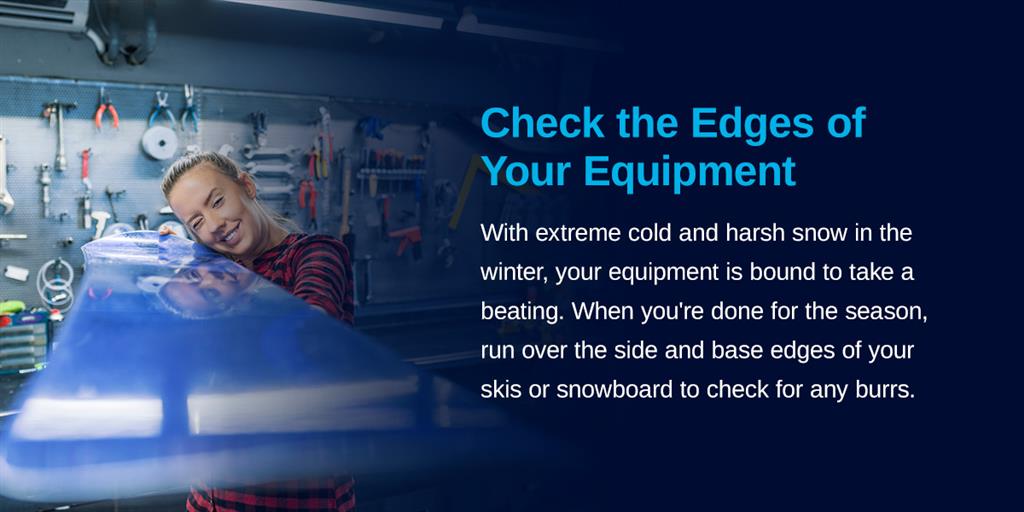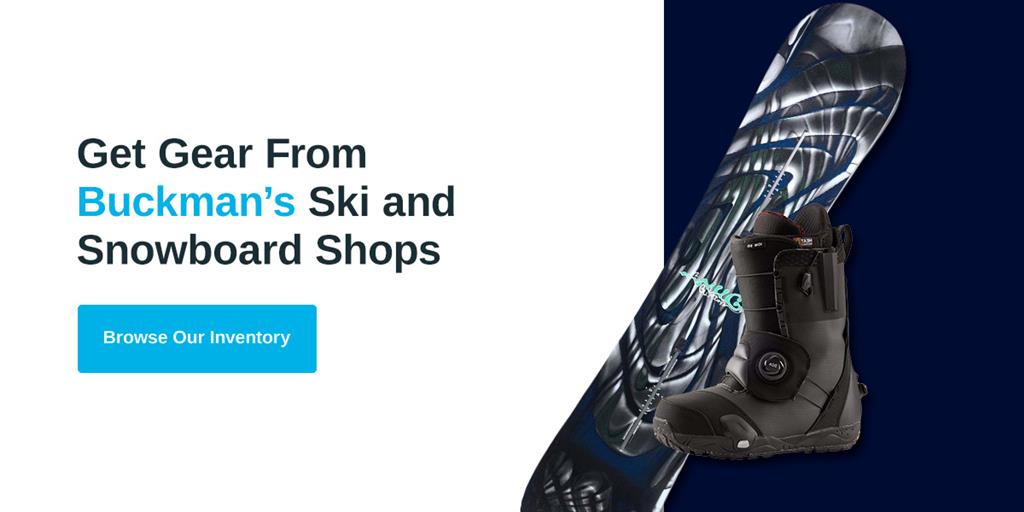 Tips to Store Ski and Snowboard Equipment
Tips to Store Ski and Snowboard Equipment
Tips to Store Skis and Snowboard for Summer
Posted
by
Matt Gahman
on Thursday, May 5, 2016
When Spring and Summer arrive, for most of the population it's time to fill up the pool, put on the SPF, and get ready for some fun in the sun. For the snow addicts out there, this time of year is considered the worst when the mountains are closed but the thought of shredding has never left. You can't shake that feeling of your boots still being on your feet, attached to your skis or board.
Sadly, your skis and snowboards probably lay in the garage, basement or attic already stowed away, just waiting to be awoken from their slumber to say hello to the next winter season. Before you put them away for the summer there are a few things to consider. After all, your gear is your chariot on snow — it deserves to be handled with delicate care. Here are some things to keep in mind.
1. Take Inventory of Your Equipment
Off-season is the perfect time to do a run-through on all of your gear. Not just boots, skis and snowboards. Let's face it, during the winter, you don’t want to shop for gear when you could be using it on the mountain. Your time on the hill is short enough and must be maximized!
A quick run-through of your jackets, pants, base layer and socks at the end of the season is a great idea. Consider replacing a piece of your gear if it didn’t work for you. For example, if you are always freezing on the hill you probably need a new base layer or socks. There is a lot of new technology out there to keep you warmer than ever.
Also, take inventory of your equipment. If your board or skis suffered any damage, now would be the ideal time to fix it.
2. Clean Your Gear Before Storing
More than likely, your weekends are spent trekking across a muddy parking lot to get back to your car after a day of shredding. Remove the grime by washing the exterior of your boots down before you store them. Remove the liners and make sure they are completely dry prior to storing. Also, be mindful of where your boots are stored. Mildew and small varmints love to live in ski or snowboard boots.
Skiers, be sure to buckle your boots loosely so they maintain shape. This is easy to forget, and when pulled out for the next season, you will discover your boots are out of shape and hard to buckle.
Snowboarders, after checking your boot liners for dryness, examine the laces. If they need to be replaced, now is the time to do it. Be sure to lace them up for storage as well as they too can lose shape.
Next, wipe down your skis and/or snowboards with a damp towel. Avoid using soaps as they often have a de-greasing property that can potentially affect binding lubrication as well as the base of the skis or snowboard.
3. Avoid Adjusting Ski Binding Tension
Snowboarders stand aside. This is for the skiers. Some may tell you to relax the spring settings on your bindings. Do not do this! Especially if you don't know how to set your DIN. Folks, the reality is that your DIN setting is based on your height, weight and your level of expertise. This can cause the binding to pre-release if done incorrectly or not to release when it should. Let's be real — you don’t want to be escorted down the mountain in the first aid sled by ski patrol on your first run of the season.
If you have not had your bindings serviced in a while, we highly recommend doing so, and no time is better than the off-season. Leave it to the experts.
4. Fix Broken Equipment
We know how costly skis and snowboards and all the other skiing equipment can be, so why not save money by taking the necessary measures to store your equipment when you're done for the season? Of course, wear and tear is something to consider when it's time to put things away, despite any attempts to keep it in a pristine condition. Accidents happen so you need to deal with any damage that may have occurred during the season.
Don't skimp on costs to repair your damaged base or your bindings. They've worked hard to give you the pleasure of skiing all throughout winter and should receive that extra special treatment.

5. Check the Edges of Your Equipment
With extreme cold and harsh snow in the winter, your equipment is bound to take a beating. When you're done for the season, run over the side and base edges of your skis or snowboard to check for any burrs, especially if you're going to tune them yourself. We don't encourage doing this unless you have experience, but that's ultimately up to you to decide.
6. Know the Best Places to Store Skis and Snowboards
Something to consider before placing your gear into hibernation is the climate where you plan to store it. They are often stored in attics, garages or basements. These places could be exposing your equipment to a climate that can adversely affect your gear.
Temperature
An attic tends to get very hot in the summer. Excessive heat is not good for snowboards or skis. The heat could potentially cause them to delaminate from the top sheet. This will not be covered under any warranty from the manufacturer or shop that sold it to you. Extreme heat can also cause the construction of the interior of the product to lose its shape, turning a camber board into an unresponsive flat board.
Humidity
You might be thinking "OK, the attic is no good, there's always the basement!", which is usually fine if your dungeon has a dehumidifier. Basements nurture a damp environment which can cause the edges of your ski or snowboard to rust. Dampness and a lack of air circulation (like when stored in a gear bag) can also cause mildew to grow.
Be sure to find a dry, climate-controlled location for summer storage. Stick your skis and snowboard upright against your closet or garage wall and buckle your boots so they don't lose their shape. Your gear will thank you!
7. Apply a Thick Coat of Wax
You don't need a reminder of the importance of waxing your ski or snowboard base, but here's one anyway. The thicker the layer of wax you apply, the better your ski or snowboard is protected against heat damage, dampness and mildew when you store it. It is especially good to add a generous rub of wax to the base to ensure it won't dry out. Your shred stick base will more than likely absorb the wax, so it should still be tuned with fresh wax in the Fall. Just don't be tempted to scratch it off when it starts drying!
8. Properly Store Boots
You want to make sure your boots are clean and prepped for storage to maintain their longevity. There are a few simple steps to clean them before you tuck them away for the next few months:
- Remove your liners.
- Take out any insoles.
- Use water and a clean cloth to clean the inside.
- Wash the liners and insoles.
- Air dry for at least 24 hours.
- Insert the liners and insoles in your boots.
- Buckle or lace up your boots.
Just like your skis or snowboards, you should avoid leaving your boots in a damp or humid area when storing them. Moisture and dampness will damage them the longer they stand, so keep them tucked away right next to your other skiing and snowboarding equipment, like one happy family, patiently waiting for the day you take them out on the slopes again.
9. Prep for Next Season!
So, you've done all you needed to in an effort to protect your ski and snowboarding equipment during the summer. They're all waxed up, cleaned, buckled and ready to hibernate while you enjoy the best of the warmer season.
Don't forget one thing — staying fit and healthy so you're ready to take on the ski season with stealth when it returns. Make sure you are in good physical condition, stay hydrated and eat well because — just like your ski and snowboarding equipment — your body takes a beating each time you hit the slopes.
The last thing you need is to suffer any injuries as a result of being not fit enough to take on the majestic mountains at their peak.

Get Gear From Buckman’s Ski and Snowboard Shops
On a lighter note, now that you are equipped with the knowledge to ensure proper storage and care of your beloved gear (and yourself!), maybe the sting of the end of this past season will dissipate... just enough for you to look forward to the much-anticipated upcoming season!
When you're gearing up for next season, remember to check out Buckman’s Ski and Snowboard Shops for all your skiing and snowboarding needs!
Categories:
Ski equipment
|
Snowboard Equipment
|
Ski & Snowboarding Tips
Tagged: ski, snowboard, ski and snowboard equipment